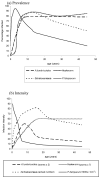The health impact of polyparasitism in humans: are we under-estimating the burden of parasitic diseases?
- PMID: 18371242
- PMCID: PMC2645487
- DOI: 10.1017/S0031182008000346
The health impact of polyparasitism in humans: are we under-estimating the burden of parasitic diseases?
Abstract
Parasitic infections are widespread throughout the tropics and sub-tropics, and infection with multiple parasite species is the norm rather than the exception. Despite the ubiquity of polyparasitism, its public health significance has been inadequately studied. Here we review available studies investigating the nutritional and pathological consequences of multiple infections with Plasmodium and helminth infection and, in doing so, encourage a reassessment of the disease burden caused by polyparasitism. The available evidence is conspicuously sparse but is suggestive that multiple human parasite species may have an additive and/or multiplicative impact on nutrition and organ pathology. Existing studies suffer from a number of methodological limitations and adequately designed studies are clearly necessary. Current methods of estimating the potential global morbidity due to parasitic diseases underestimate the health impact of polyparasitism, and possible reasons for this are presented. As international strategies to control multiple parasite species are rolled-out, there is a number of options to investigate the complexity of polyparasitism, and it is hoped that that the parasitological research community will grasp the opportunity to understand better the health of polyparasitism in humans.
Figures


References
-
- Abdel-Salam E, Abdel Khalik A, Abdel-Meguid A, Barakat W, Mahmoud AA. Association of HLA class I antigens (A1, B5, B8 and CW2) with disease manifestations and infection in human schistosomiasis mansoni in Egypt. Tissue Antigens. 1986;27:142–146. - PubMed
-
- Anderson RM, May RM. Infectious Diseases of Humans: dynamics and control. Oxford University Press; Oxford: 1991.
-
- Asobayire FS, Adou P, Davidsson L, Cook JD, Hurrell RF. Prevalence of iron deficiency with and without concurrent anemia in population groups with high prevalences of malaria and other infections: a study in Cote d’Ivore. American Journal of Clinical Nutrition. 2001;74:776–782. - PubMed
-
- Beisel WR. Nutrition in pediatric HIV infection: Setting the research agenda. Nutrition and immune function: Overview. Journal of Nutrition. 1996;126 - PubMed
-
- Bloem MW, Wedel M, Van Agtmaal EJ, Speek AJ, Soawakontha S, Schreurs WHP. Vitamin A intervention: short term effects of a single oral massive dose on iron metabolism. American Journal of Clinical Nutrition. 1990;51:76–79. - PubMed
Publication types
MeSH terms
Grants and funding
LinkOut - more resources
Full Text Sources
Medical
Molecular Biology Databases
Research Materials

